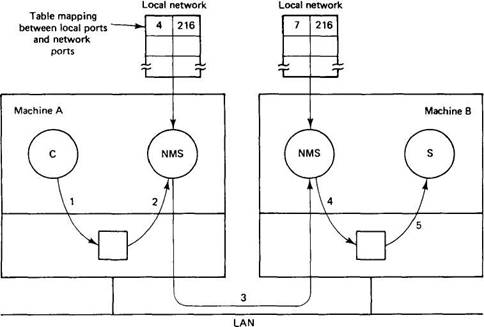Книга: Distributed operating systems
8.4.3. The Network Message Server
8.4.3. The Network Message Server
Everything we have said so far about communication in Mach is limited to communication within a single node, either one CPU or a multiprocessor node. Communication over the network is handled by user-level servers called network message servers, which are vaguely analogous to the external memory managers we studied earlier. Every machine in a Mach distributed system runs a network message server. The network message servers work together to handle intermachine messages, trying to simulate intramachine messages as best they can.
A network message server is a multithreaded process that performs a variety of functions. These include interfacing with local threads, forwarding messages over the network, translating data types from one machine's representation to another's, managing capabilities in a secure way, doing remote notification, providing a simple network-wide name lookup service, and handling authentication of other network message servers. Network message servers can speak a variety of protocols, depending on the networks to which they are attached.
The basic method by which messages are sent over the network is illustrated in Fig. 8-20. Here we have a client on machine A and a server on machine B. Before the client can contact the server, a port must be created on A to function as a proxy for the server. The network message server has the RECEIVE capability for this port. A thread inside it is constantly listening to this port (and other remote ports, which together form a port set). This port is shown as the small box in A's kernel.

Fig. 8-20. Intermachine communication in Mach proceeds in five steps.
Message transport from the client to the server requires five steps, numbered 1 to 5 in Fig. 8-20. First, the client sends a message to the server's proxy port. Second, the network message server gets this message. Since this message is strictly local, out-of-line data may be sent to it and copy-on-write works in the usual way. Third, the network message server looks up the local port, 4 in this example, in a table that maps proxy ports onto network ports. Once the network port is known, the network message server looks up its location in other tables. It then constructs a network message containing the local message, plus any out-of-line data and sends it over the LAN to the network message server on the server's machine. In some cases, traffic between the network message servers has to be encrypted for security. The transport module takes care ofbreaking the message into packets and encapsulating them in the appropriate protocol wrappers.
When the remote network message server gets the message, it looks up the network port number contained in it and maps it onto a local port number. In step 4, it writes the message to the local port just looked up. Finally, the server reads the message from the local port and carries out the request. The reply follows the same path in the reverse direction.
Complex messages require a bit more work. For ordinary data fields, the network message server on the server's machine must perform conversion, if necessary, for example, taking account of different byte ordering on the two machines. Capabilities must also be processed. When a capability is sent over the network, it must be assigned a network port number, and both the source and destination network message servers must make entries for it in their mapping tables. If these machines do not trust each other, elaborate authentication procedures will be necessary to convince each machine of the other's true identity.
Although the idea of relaying messages from one machine to another via a user-level server offers some flexibility, a substantial price is paid in performance as compared to a pure kernel implementation, which most other distributed systems use. To solve this problem, a new version of the network communication package is being developed (the NORMA code), which runs inside the kernel and achieves faster communication. It will eventually replace the network message server.
- Usenet Network Newsgroups
- 7.5.3. The Fast Local Internet Protocol
- Send Messages to NetWare Users
- Mail Routing on the Internet
- The Real-time Blackhole List
- Тестирование Web-сервиса XML с помощью WebDev.WebServer.exe
- InterBase Super Server для Windows
- Каталог BIN в SuperServer
- Минимальный состав сервера InterBase SuperServer
- InterBase Classic Server под Linux
- Каталог BIN в InterBase Classic Server для Linux
- SuperServer




